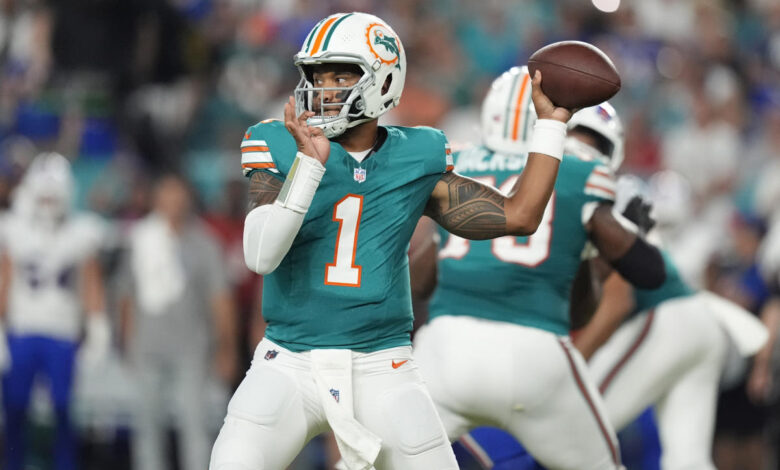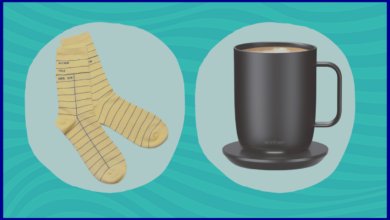Dolphins QB Tua Tagovailoa sustained another concussion. Why multiple head traumas are cause for serious concern.

During Thursday night’s game against the Buffalo Bills, Tua Tagovailoa, starting quarterback for the Miami Dolphins, sustained a concussion that took him out of the game. It isn’t the first time the 26-year-old has left the field with a head injury; the latest was the third concussion Tagovailoa has been diagnosed with during his five-year National Football League career. In fact, one of his prior injuries resulted in a change to the NFL’s return-to-play rules. And with this latest head injury, some former players are urging Tagovailoa to consider retiring to protect his brain health.
Here’s what to know about Tagovailoa’s multiple concussions, and why experts say they’re cause for serious concern.
What happened to Tua Tagovailoa?
While running for a touchdown, Tagovailoa collided headlong with the chest and arm of the Bills’ safety, Damar Hamlin (who, coincidentally, made headlines last year when he suffered cardiac arrest during a game and was revived on the field). Tagovailoa’s body appeared to crumple into Hamlin, before he fell backwards, his helmet bouncing against the turf. “Tua’s head jerked violently to the side and, when he went to the ground, he was showing what’s called the fencing posture, which means he was unconscious,” Chris Nowinski, CEO of the Concussion Legacy Foundation, tells Yahoo Life. The fencing posture is “basically a deep reflex in the brain that causes one of his arms to go straight and his fist was balled up; it indicates that the brain stem was involved and is a sign of a more severe concussion,” he adds.
Tagovailoa eventually walked off the field unassisted, but was diagnosed with a concussion within minutes. Dolphins head coach Mike McDaniel said Tagovailoa was in good spirits during a press conference following the game, but it’s not yet clear when the quarterback will return to play.
Why it’s a big deal
A concussion, or traumatic brain injury, can affect how the brain works. Multiple concussions, like Tagovailoa has had, are more likely to do so, experts say. And he’s likely had more than three such injuries, Nowinski suspects. “He’s just had three diagnosed in the last two years in the NFL,” he says. “He had a long career before the NFL. The more concussions you get, the greater the risk of cognitive and mental health problems later on.”
A concussion can cause headaches, changes in alertness, loss of consciousness, memory loss, and changes in thinking, according to Penn Medicine. In rare cases, these effects can be long-lasting, or progress to more severe neurological problems and disease, including seizures, mood or personality changes and mobility or balance issues. But with each additional concussion, the likelihood that the next will be severe increases, experts say.
One study found that athletes with a history of three or more concussions are significantly more likely to lose consciousness, have memory loss or “mental status changes” that last longer than five minutes. Another study found that those who have had three or more concussions had worse brain function later in life than those who had fewer or no concussions. “There’s no question that repeated severe concussion events put you at risk for severe neurological disease later in life,” Dr. Alexander Khalessi, a University of California, San Diego, neurosurgeon, tells Yahoo Life.
In extreme cases, repeated blows to the head can lead to a degenerative brain disease called chronic traumatic encephalopathy (CTE). Symptoms include behavioral and mood changes, including aggression, impulse control problems and paranoia, as well as cognitive changes that affect memory and judgment, and sleep problems, according to the Concussion Legacy Foundation.
The vast majority of people diagnosed with CTE are athletes who play contact sports, such as football or rugby, as well as military service members (and, less commonly, victims of violence). It happens to people who have suffered hundreds of hits to the head, which may include concussions. But a few concussions alone are unlikely to lead to the disease. “There is not a statistical correlation between the number of diagnosed concussions and CTE,” says Nowinski. “However, CTE is a concern already, as 91.7% of NFL players studied have had CTE, and many never had diagnosed concussions.”
Players can sustain many concussions over their career. The NFL is finally trying to change that.
In 2007, a forensic neuropathologist first discovered signs of CTE-like damage in the brain of the late NFL player Andre Waters, who had died by suicide months prior. In the years that followed, pathologists have concluded that multiple former NFL players who died by suicide suffered from CTE, including some cases of murder-sucide. Analysis of the brain of Aaron Hernandez, a former tight end with the New England Patriots who died by suicide following his murder conviction in 2013, showed CTE too.
The difficult-to-ignore link between athletes’ repeated brain injuries and later acts of violence was a reckoning for the NFL. “The NFL has been taking concussions a little more seriously each year,” says Nowinski. “Only 15 years ago we had to fight them to hold players out of the game after they were knocked unconscious.” For example, former quarterback Brett Favre claims he sustained thousands of concussions over the course of his NFL career. Most were undiagnosed — and that’s exactly the problem that Nowinski continues to come back to.
The NFL introduced new protocols in 2011 for spotting potential concussions on the field, diagnosing them as soon as possible, keeping neurologists on hand during game, and immediately sidelining and assessing any player with a suspected concussion (though the league didn’t officially recognize the link between on-field concussions and CTE until 2016). Millions of dollars have also been funneled from the NFL into research to improve player safety, including with Guardian Caps, specialized helmets intended to absorb some of the force of a hit.
But for Tagovailoa — who had a hard landing during a 2022 game, followed by another one four days later, which led to his first concussion diagnosis and prompted the NFL to update its concussion protocols — there’s a concern the damage may have already been done.
Now some former players and experts are urging Tagovailoa to retire to protect his neurological health. Nowinski — himself a retired wrestler — says he doesn’t think that’s necessary yet, and notes that other players have had successful careers after major concussions. But he adds that it’s worth considering. “I would strongly suggest a conversation with his family where he considers whether football is worth the money, or he should start his second career now,” says Nowinksi.
He adds: “We already know that each year of playing football increases the odds of developing CTE. When you add the risk of post-concussion syndrome or a new mental health disorder from concussions, it’s a good time to remember that we only have one brain, and once it’s damaged, we don’t necessarily know how to fix it.”




